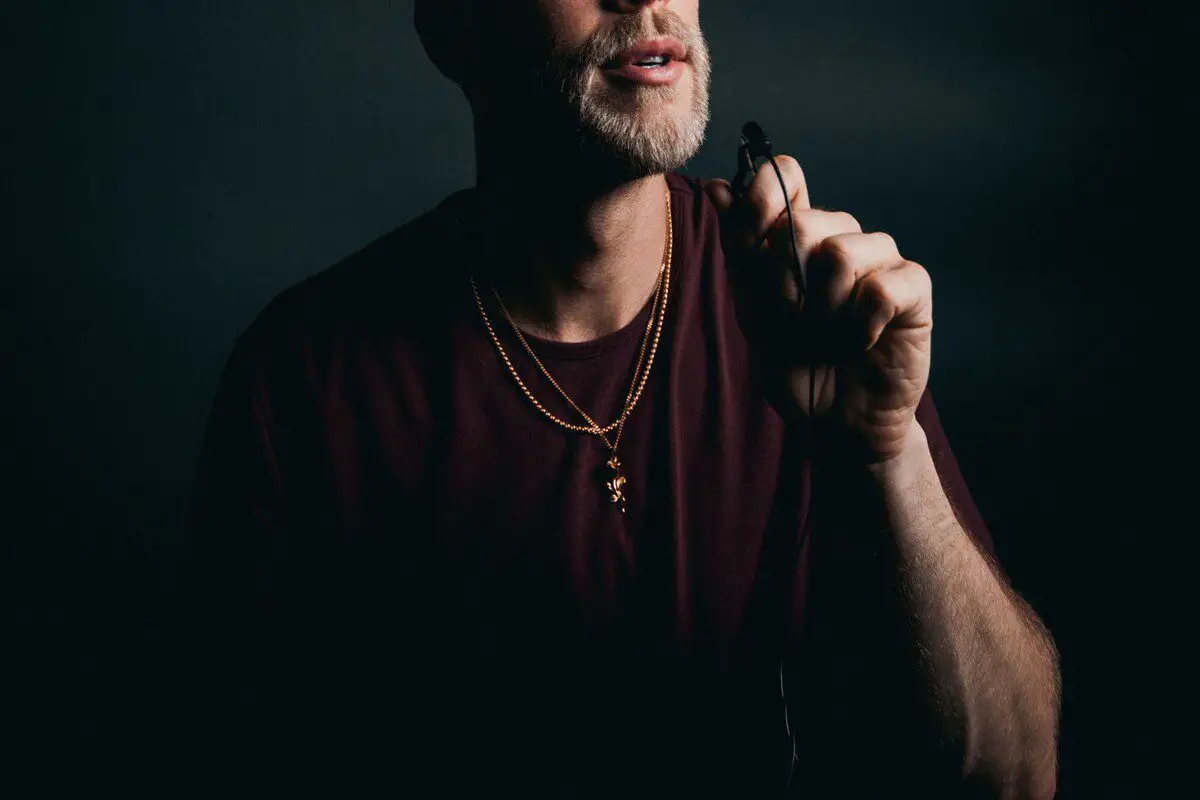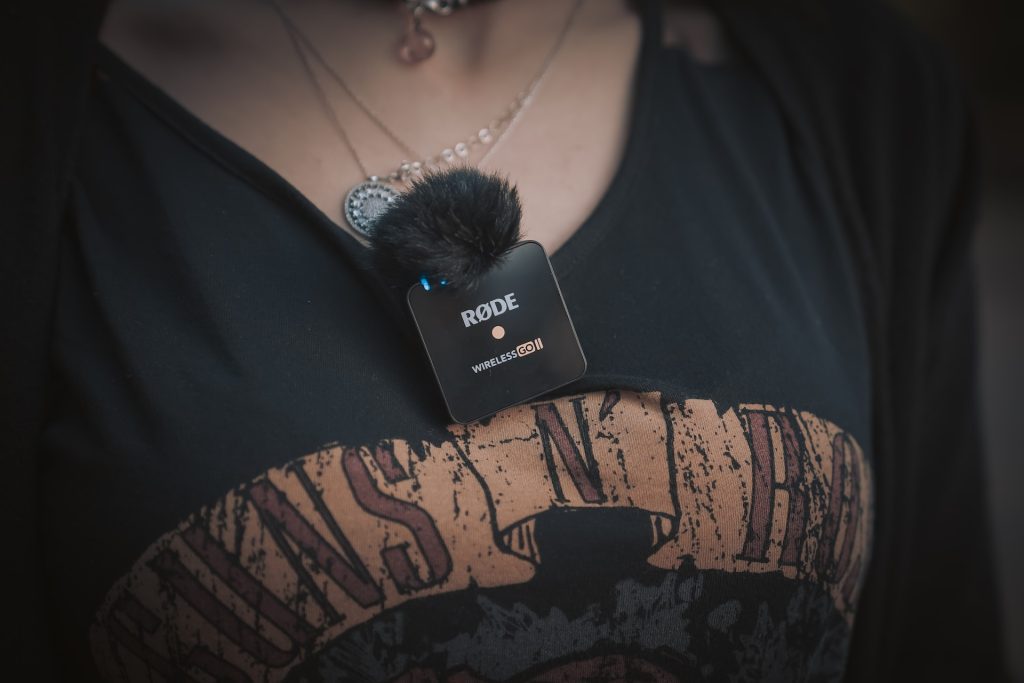Picture this: You’re at an epic wedding, and the best man steps up to deliver his toast. He’s got his phone out, scrolling through his notes. He’s got a lavalier microphone clipped to his lapel, and his hands are free to gesture wildly and make everyone laugh. Magic, right? You’re probably wondering what a lavalier microphone is. In this post, you’ll learn about how these tiny yet powerful mics work. Ready to rock and roll?
What is a lavalier microphone? A lavalier microphone, also known as a lav, lapel, or clip-on mic, is a small, discreet microphone typically attached to a person’s clothing to capture their voice while keeping their hands free.
What are lavalier microphones?
Lavalier microphones, or lav mics as the cool kids call ’em, are all about making your life easier when you need to capture audio without the hassle of holding a mic. Here’s the lowdown on these little audio wonders:

- Small and unobtrusive
- Clip onto clothing or hide in costumes
- Provide hands-free audio recording
Imagine you’re shooting a video interview or a podcast, and you want the audio to be clear, but you don’t want a big ol’ microphone in the frame. That’s where lavalier mics come to the rescue! They’re perfect for situations where you need to keep the focus on the person speaking, not the gear they’re using. Plus, they let your subjects move around freely, which can be a game-changer for dynamic performances or interviews.
I remember the first time I encountered a lavalier microphone. I was just starting out as a music producer, and a friend asked me to help record a live performance of her acoustic duo. I quickly realized that traditional handheld mics wouldn’t work, as they needed their hands free to play their instruments. That’s when I discovered lavalier mics – they were an absolute lifesaver! I clipped one onto each musician’s shirt, and the result was clear, crisp audio that let their talent shine through.
AKAI Professional MPK Mini MK3

AKAI Professional MPK Mini MK3
How do lavalier mics work, and what makes them unique?
Lavalier microphones are a breed of their own, and understanding how they work can help you make the most out of them. So, what sets these mini audio magicians apart?
1. Omnidirectional pickup pattern
Most lavalier mics have an omnidirectional pickup pattern, which means they capture sound from all directions. This makes them perfect for capturing natural-sounding audio without worrying too much about mic placement. Just clip it on, and you’re good to go!
2. Condenser microphone design
Lavalier mics are usually condenser microphones, which means they’re sensitive to sound and can capture a wide frequency range. This makes them ideal for capturing clear, detailed audio from speech and vocals.
3. Phantom power or battery-powered
Lav mics need power to work, which usually comes from phantom power (provided by an audio interface, mixer, or recorder) or an internal battery. This flexibility means they can be used in a wide range of situations, from studio recordings to on-the-go interviews.
Let’s say you’re recording a podcast with a guest who’s super animated and constantly moving around. A traditional handheld or stand-mounted microphone might not capture their voice consistently as they move, but a lavalier mic with an omnidirectional pickup pattern will keep their audio sounding smooth and natural, no matter how much they wiggle and groove.

When should you use a lavalier microphone?
While lavalier microphones are pretty rad, they’re not always the best choice for every situation. So, when should you opt for a lavalier mic? Here are some prime scenarios:
1. Interviews and presentations
As I mentioned earlier, lav mics are perfect for interviews and presentations. They’re discreet, hands-free, and can capture clear audio even if the speaker is moving around.
2. Theater and film
Actors in plays or films often use lavalier microphones hidden in their costumes or hair to keep the focus on their performance, not the audio equipment. It’s all about that invisible audio magic!
Musicians who need their hands free for playing instruments can benefit from using lavalier microphones.
3. Live performances
Musicians who need their hands free for playing instruments can benefit from using lavalier microphones. Acoustic guitarists, keyboardists, and even some drummers have been known to rock lav mics on stage.
4. Content creation
Suppose you’re a YouTuber, streamer, or any other type of content creator. In that case, a lavalier mic can be a great choice for recording high-quality audio without the bulk of a traditional microphone setup.
That being said, lavalier microphones might not be the best option for certain situations. For instance, if you’re recording a podcast with multiple guests in a studio setting, a roundtable discussion, or capturing the sound of a live band, you may want to consider using other types of microphones that are better suited for those scenarios.
What are some popular lavalier microphone models to consider?
So, you’re ready to hop on the lavalier microphone bandwagon, but with so many options out there, how do you choose the perfect one for your needs? I’ve got your back with a list of some popular lavalier microphone models that cater to various budgets and requirements. The table below presents a comprehensive comparison of the top lavalier microphones available in the market as of 2023.
| Model Name | Price Range (USD) | Signal-to-Noise Ratio (dB) | Maximum SPL (dB) | Cable Length (ft) | Power Requirement |
|---|---|---|---|---|---|
| Audio-Technica ATR3350iS | 60 – 80 | 74 | 121 | 20 | Battery |
| Rode SmartLav+ | 60 – 75 | 67 | 110 | 4.5 | Plug-in Power |
| Shure MVL | 70 – 90 | 65 | 124 | 4.9 | Plug-in Power |
| Sennheiser ME 2-II | 130 – 150 | 74 | 130 | 5.2 | Phantom Power |
| Rode Lavalier GO | 80 – 100 | 67 | 110 | 4.2 | Plug-in Power |
| Sony ECMCS3 | 20 – 40 | 90 | 122 | 3 | Battery |
| Deity V.Lav | 50 – 70 | 84 | 114 | 16.4 | Plug-in Power |
Advantages and disadvantages of lavalier microphones
Lavalier microphones, also known as lapel mics, offer a variety of benefits and downsides in different recording situations. Their unique characteristics make them either a go-to choice or a last resort, depending on the specific requirements of the audio recording or amplification task at hand.
Advantages of lavalier microphones
One of the key virtues of lavalier microphones is their versatility. Let’s take a closer look at some of the distinct advantages they offer:
- Unobtrusiveness: Lavalier mics are small and can be clipped onto clothing, making them almost invisible, which is especially useful for video productions.
- Hands-free Operation: They allow the speaker to use their hands freely during presentations, performances, or interviews, enhancing natural gestures and expressions.
- Mobility: Their wireless versions provide greater freedom of movement, unencumbered by the tether of a microphone stand.
- Consistent Audio Quality: Since they are attached close to the mouth, lavalier mics can maintain consistent audio quality, even if the speaker turns their head or moves around.
- Ease of Use: They are simple to use, requiring only attachment to the speaker’s clothing and a basic audio check.
Disadvantages of lavalier microphones
However, like any other equipment, lavalier microphones also come with their fair share of limitations. Here are some of the challenges they pose:
- Clothing Noise: They can pick up unwanted noise from clothing or jewelry, which may interfere with the quality of the sound.
- Wind Noise: When used outdoors, they are susceptible to wind noise and may require additional equipment like windshields to mitigate this issue.
- Battery Dependence: Wireless lavalier mics depend on batteries, which might run out during a performance or recording, causing inconvenient interruptions.
- Less Control Over Audio Capture: Their fixed position means less control over what they capture. If the speaker turns away, the audio can be inconsistent.
- Potential Interference: Wireless lavalier mics can suffer from radio frequency interference, which can compromise sound quality.
By weighing these advantages and disadvantages, one can make an informed decision about whether a lavalier microphone is the best choice for a particular situation. It’s all about finding the right tool for the right job!
If you want even more tips and insights, watch this video called “When Should You Use A Lavalier Microphone?” from the Tom Buck YouTube channel.
Frequently asked questions (FAQ)
Do you still have questions about a lavalier microphone? Below are some of the most commonly asked questions.
Can I use a lavalier microphone with my smartphone?
Yes, certain lavalier microphones are designed to work with smartphones, such as the Rode SmartLav+ and Shure MVL. Just make sure the lav mic you choose is compatible with your specific smartphone model and has the appropriate connector.
How do I properly attach a lavalier microphone to clothing?
To attach a lavalier microphone to clothing, clip the mic onto the subject’s clothing approximately 6-8 inches below their chin. Position the mic to face the speaker’s mouth to capture the best audio quality. Make sure the cable is secured and hidden, and avoid placing the mic near any fabric that might cause a rustling noise during movement.
Are there wireless lavalier microphones available?
Absolutely! Wireless lavalier microphones are available for those who need more freedom of movement during performances, presentations, or interviews. These systems typically include a transmitter pack that connects to the microphone and a receiver that connects to your recording device.
Conclusion
Well, there you have it – the lowdown on lavalier microphones! These discreet audio wizards can be real lifesavers in the right situations. But remember, with great power comes great responsibility – or, in this case, with great audio comes great mic-sponsibility!
So, have I answered all your burning questions about lavalier microphones? If you have any more questions or suggestions, feel free to drop a comment below. I read and reply to every comment. And if you found this article helpful, don’t forget to share it with your friends and check out my full blog for more tips and tricks on all things audio. Thanks for reading, and may your audio adventures be lav-ishly awesome!
Key takeaways
This article covered the ins and outs of lavalier microphones. Here are some key takeaways:
- Lavalier microphones are small, discreet microphones that clip onto clothing or costumes.
- They’re ideal for interviews, presentations, theater, film, live performances, and content creation.
- Popular lavalier microphone models include the Rode SmartLav+, Sennheiser ME 2-II, Audio-Technica ATR3350iS, Shure MVL, and Deity V.Lav.
- Lavalier mics offer hands-free operation, discreetness, omnidirectional pickup, and versatility.
- Drawbacks include susceptibility to clothing noise, wind noise, limited isolation, and power requirements.
- Wireless lavalier microphone systems are available for added freedom of movement.















